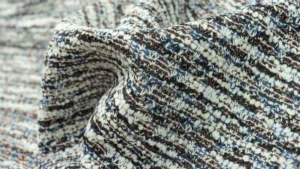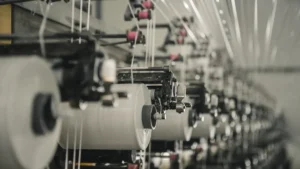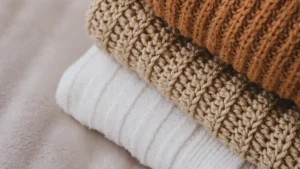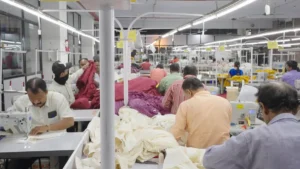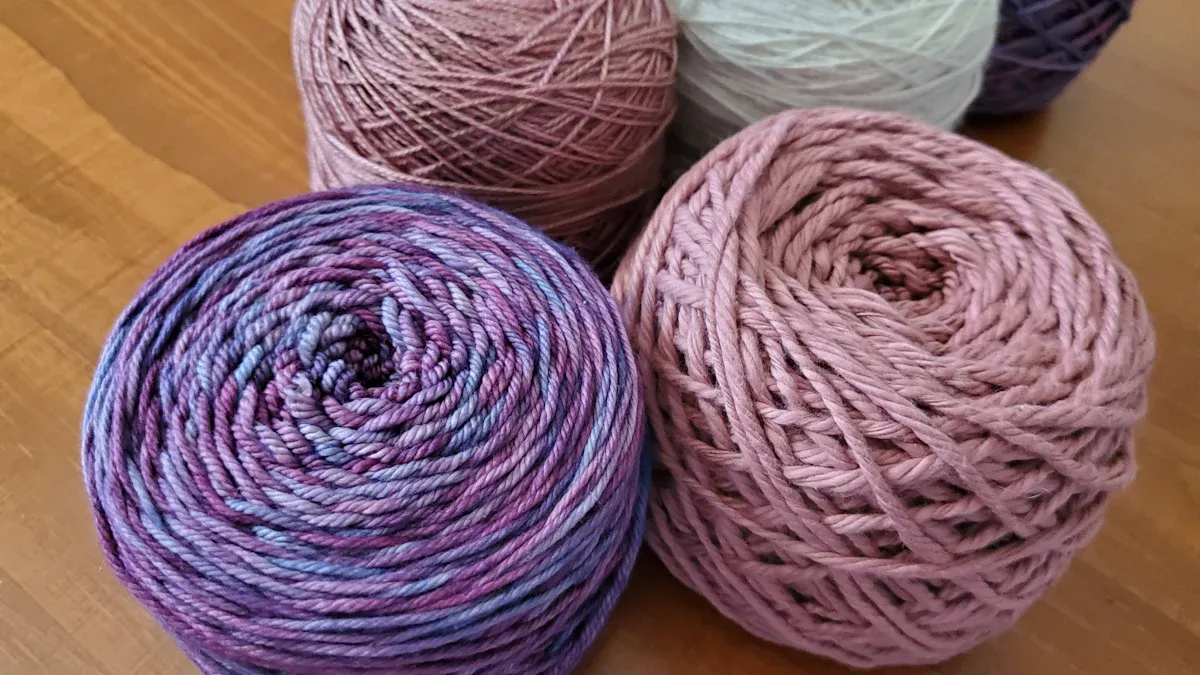
Choosing the best knitwear fabric blends for your brand means you must know your goal. You should also know your market and what your clothes need to do. You want fabric that feels good and lasts a long time. It should also meet what customers want. For example, fabrics can lose up to 17.1% bursting strength after pilling. So, quality and durability are important.
Metric | Description | Values / Range |
|---|---|---|
Bursting strength decrease after pilling | Shows how much durability is lost | Up to 17.1% decrease |
Fabric weight | How heavy the fabric is | 179 to 263 g/m² |
Stitch density | How many stitches in one square cm | 49.0 to 104.7 cm⁻² |
Customers now want comfort, easy care, and eco-friendly choices in knitwear fabric blends. Brands that give these things earn trust and stand out.
Key Takeaways
You should know your brand’s goal and who your customers are before picking fabric blends. This helps you avoid expensive mistakes.
Choose fabric blends that match your product’s style and price. Think about the season or weather where people will wear your clothes.
Use natural fibers if you want comfort and to help the environment. Use synthetic fibers if you need strong and long-lasting clothes. Blends can give you both good things.
Check fabric quality with easy tests and lab tests. This makes sure your clothes are strong, comfy, and fit well before you buy a lot.
Pick your suppliers with care. Order fabric samples and test them. Keep testing to make your knitwear better and make your customers happy.
Brand Needs
Purpose & Market
Start by knowing what your brand stands for. You also need to know who will buy your clothes. The knitwear market is getting bigger every year. Brands now pick fabric blends to fit what people want in different places. Some brands use eco-friendly fibers. Others use digital tools to guess what will be popular and change their blends fast. If your brand is for active people, pick blends that stretch and keep sweat away. If you want a luxury brand, use special fibers like linen or high-quality cotton. Your brand’s style affects every piece you make.
Tip: Figure out what your brand values and what your customers want before picking any fabric. This helps you avoid mistakes that cost money.
Product Style
The look of your clothes changes what fabric you need. Yarn types and how the fabric is made change how clothes feel and work. A light cotton-linen blend is good for summer tops. A thick linen-wool blend is better for cold weather. Yarn twist and how tight the fabric is can change how warm or cool it feels. Brands like Uniqlo and Lululemon use these ideas to make comfy and stylish knitwear. Always pick fabric that fits the style and job of your clothes.
Price Point
How much your clothes cost decides what fabrics you can use. Eco-friendly fibers like organic cotton or linen usually cost more. These fibers are liked by people who care about the planet. The price of raw materials can go up and down fast. You need to think about both cost and how well the fabric works. Blends like polyester-spandex help with stretch and keeping dry, which can make higher prices fair. If you want to sell cheaper clothes, use blends with less costly fibers but still make sure they are comfy and last long.
Think about these things for price:
How much raw materials cost (cotton, linen, synthetics)
What the fabric can do
If buyers will pay more for green or new ideas
Season & Climate
The time of year and weather matter when picking fabric. Cotton and linen blends are good for hot days because they are light and let air in. Wool or thick linen blends are better for cold days because they keep you warm. Some brands now make clothes for all seasons by mixing fibers like wool and linen. This makes clothes work in many kinds of weather. Cotton is soft and lets skin breathe. Polyester makes fabric strong and helps keep water out. Picking the right blend means your clothes will work for customers all year.
Knitwear Fabric Blends
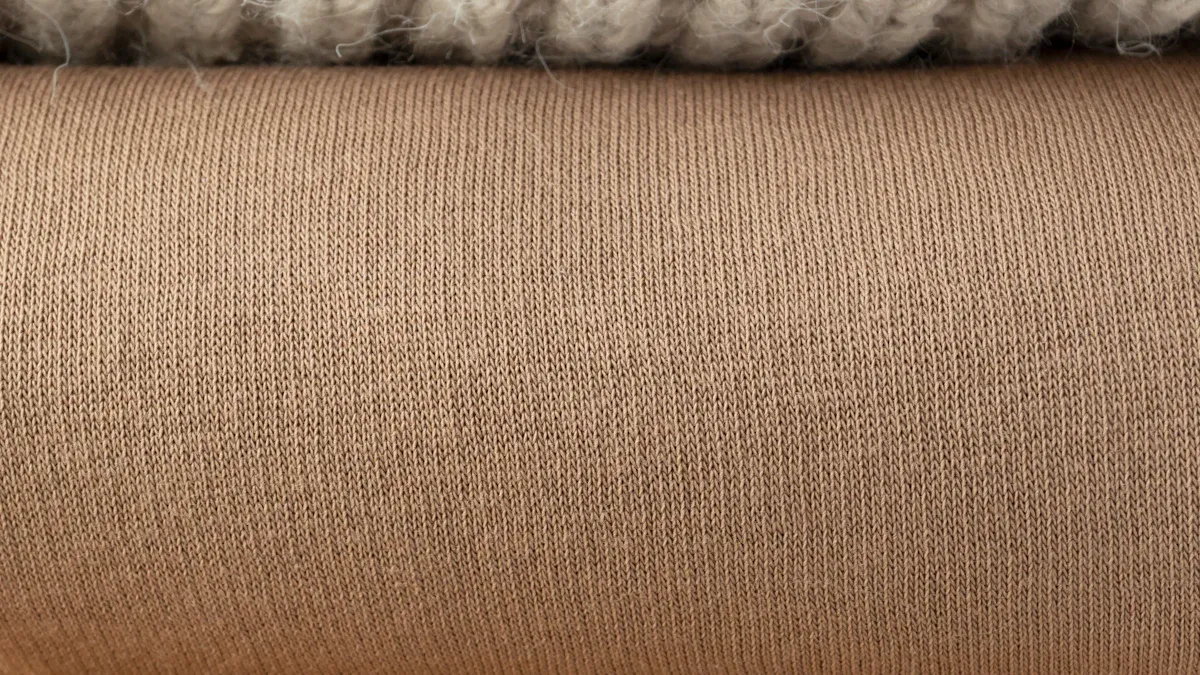
Natural Fibers
There are many natural textiles used in knitwear. Cotton, linen, wool, and silk are the most common ones. These fibers come from plants or animals. They feel soft and let your skin breathe. Cotton and linen help you stay cool in summer. Wool and silk keep you warm in winter. Organic cotton knit is gentle on skin and better for the earth. Linen feels crisp and dries quickly. Wool keeps heat in and feels cozy. Silk is shiny and smooth to touch. Natural fibers soak up sweat and let air move through. This makes them very comfortable.
Natural textiles are also good for the environment. They break down over time and do not hurt nature. Hemp blends with cotton or viscose help control moisture and let air in. These blends keep you dry and cool. Hemp also makes knit fabric stronger. If you want eco-friendly choices, organic cotton knit and linen blends are great.
Note: Cotton, linen, wool, and silk are natural fibers. They are soft, let air in, and are good for the planet. They are best for brands that want eco-friendly and soft fabrics.
Property | |
|---|---|
Moisture Management | Great at soaking up sweat and letting air in |
Tensile Behavior | Medium strength; hemp is stronger than cotton |
Air Permeability | Lets more air through, making it comfy |
Abrasion Resistance | Not as strong against rubbing |
Comfort Properties | Breathes well, soaks up sweat, and is good for nature |
Synthetic Fibers
Synthetic fibers are made by people, not found in nature. Polyester, nylon, and acrylic are the most used types. These fibers make knitwear fabric blends strong and last longer. Polyester does not wrinkle and keeps its shape. Nylon adds stretch and makes fabric tough. Acrylic is soft and feels like wool. Synthetic fibers dry fast and do not shrink much.
Synthetic fibers do not let air in as well as natural ones. They can trap heat and sweat, which may feel uncomfortable. But they make clothes last longer and stronger. Polyester mixed with cotton or linen helps stop wrinkles and keeps shape. Synthetic fibers usually cost less than natural ones.
Synthetic fibers in knitwear fabric blends:
Make fabric stronger and harder to tear
Help move sweat when mixed with natural fibers
Are easy to wash and dry quickly
Property | Synthetic Fibers (Polyester, Repreve®) |
|---|---|
Moisture Management | Not as good at soaking up sweat, can trap heat |
Tensile Behavior | Stronger and harder to tear |
Air Permeability | Lets less air in, can feel hot |
Abrasion Resistance | Stands up to rubbing better |
Comfort Properties | Not as comfy, can feel hot |
Popular Blends
Blends mix natural and synthetic fibers together. This gives you fabric that is comfy, strong, and looks nice. Cotton-polyester is a very popular blend. It feels soft, does not wrinkle, and keeps its shape. Wool-cashmere blends are warm and feel fancy. Linen-cotton blends are light and cool for hot days. Silk-wool blends are shiny, soft, and warm.
Many brands use blends to give customers what they want. Uniqlo and Lululemon use cotton-polyester and wool blends for comfort and strength. Fancy brands like Acne Studios use silk and wool for a special feel. Eco-friendly brands pick organic cotton knit and linen blends. Blends also help with stretch, keeping sweat away, and easy washing.
Trends for knitwear fabric blends:
Cotton/polyester blends sell the most, worth over USD 7 billion in 2016
Nylon/wool blends are getting more popular for warmth and strength
Organic cotton knit and linen blends are liked by people who care about the planet
Silk blends make fabric shiny and fancy
Aspect | Details |
|---|---|
Key Fiber Blends | Cotton/Polyester, Nylon/Wool, Silk/Wool, Linen/Cotton |
Performance Benefits | Stops wrinkles, keeps shape, soft, soaks up sweat, strong, warm, comfy |
Application Areas | Used in clothes, home items, and protective gear |
Tip: Blends let you change comfort, strength, and price. Try different mixes to see what works for your brand.
Cotton Spandex Jersey
Cotton spandex jersey is one of the most useful knit fabrics. You see it in t-shirts, leggings, dresses, and sports clothes. This fabric is soft because of cotton and stretchy because of spandex. It moves with you and keeps its shape.
Cotton spandex jersey can stretch a lot, up to 500-600%. It goes back to its shape, so clothes do not get loose. This fabric feels soft and smooth on your skin. It pulls sweat away, so you stay dry when active. The fabric is light, so you feel comfy all day. Cotton spandex jersey keeps its color even after many washes.
You can use cotton spandex jersey for many types of clothes. It works for tight tops, yoga pants, and dresses. The fabric lets you move easily and does not hold you back. Organic cotton knit versions are better for the planet. Brands like Lululemon and H&M use this fabric for comfort and stretch.
Property/Feature | Description/Benefit |
|---|---|
High Elasticity | Spandex stretches a lot, so clothes fit well and move with you. |
Excellent Recovery | Goes back to shape, so clothes do not sag. |
Durability | Very strong, so clothes last a long time. |
Moisture-Wicking | Pulls sweat away, so you stay dry and comfy. |
Lightweight | Not heavy, so clothes feel good for sports and daily wear. |
Softness and Texture | Feels silky and soft, making it nice to wear. |
Color Retention | Keeps color bright after many washes. |
Thermal Regulation | Helps keep you cool or warm when mixed with other fibers. |
Flexibility and Movement | Stretches in all ways, so you can move freely. |
Shape Retention | Clothes keep their fit and look after many wears and washes. |
Sustainable Innovations | New bio-based spandex helps make fabric better for the earth. |
Callout: Cotton spandex jersey gives you comfort and stretch. It works for many kinds of clothes, from casual to sports.
Cotton spandex jersey is also good for the planet. New bio-based spandex makes it even greener. You can pick organic cotton knit for a more eco-friendly choice. This fabric works in every season and fits many body shapes. It is easy to wash and keeps looking good after many washes.
Best Fabric Blend Selection
Right Fabric for Purpose
You need to pick fabric that matches what the clothing will do. Different clothes need different blends to work their best. Activewear needs fabric that stretches, pulls sweat away, and keeps its shape. Cotton spandex jersey is great for sports tops and leggings because it moves with you and feels comfy. If you want to make fancy knitwear, you might use a wool-cashmere blend for softness and warmth. For everyday clothes, cotton-polyester jersey is easy to care for and lasts a long time.
Think about what your customers will do in your clothes. Sports bras and leggings need to stretch a lot and bounce back. Sweaters and cardigans should feel warm and soft. Picking the right fabric helps your customers feel good and look nice. The best fabric blend always fits what the clothing is made for.
Tip: Always ask yourself, “What will this clothing do?” before you choose a fabric blend.
Climate & Comfort
The weather matters a lot when you pick fabric. You want your customers to feel good in every season. In hot weather, you need fabric that lets air in and dries fast. Cotton-linen jersey is light and lets skin breathe, so it is great for summer tops. In cold weather, wool or wool-blend jersey keeps you warm by holding in heat.
Performance numbers help you see how fabric works in different weather. Here is a table that shows how fabric features link to comfort:
Performance Metric | Description / Measurement Method | Linked Fabric Characteristics | Climate-Specific Comfort Implication |
|---|---|---|---|
Air Permeability (mm/s) | Measured at 100 Pa air pressure (ISO 9237:1995) | Fabric thickness, porosity, bulk density | High air permeability is good for hot weather because it lets air in and cools you down |
Moisture Management Properties | Assessed by Moisture Management Tester (AATCC 195:2011) | Wetting time, max wetted radius, spreading speed, absorption rate, OMMC | High OMMC and good moisture movement help manage sweat, which is important for comfort in both hot and cold weather |
Drying Time | Time taken for fabric to dry after moisture exposure | Fabric density, thickness, fiber blend | Short drying time keeps you from feeling damp, which is good in humid or active times |
Thermal Conductivity | Ability to conduct heat through fabric | Fiber type, fabric structure | High thermal conductivity helps you stay cool in warm weather; low conductivity keeps you warm in cold weather |
Water Vapor Permeability (WVP) | Measured by inverted cup method (ISO 15496:2015) | Fabric porosity, fiber type | High WVP lets sweat vapor out, which helps you feel better in hot or humid weather |
You can use these numbers to pick the best fabric for your weather. For example, high air permeability and good sweat control are important for summer tops. In winter, low thermal conductivity and good sweat wicking keep you warm and dry. Always test your fabric to see how it works in real life.
Design & Fit
How your clothes look and fit is just as important as the fabric. You want your clothes to fit many people and feel good all day. The right fabric blend helps you do this. Jersey with spandex stretches and bounces back, so clothes fit close but do not feel tight. Cotton jersey is soft and works well for loose t-shirts and dresses.
If you use the wrong fabric in sports bras, it can cause problems in the cups, bands, and straps. You need blends that support the body and move with it. In sportswear, how the fabric works depends on the fiber, blend, and how it is knitted. Sweat control, breathability, and stretch all help make clothes comfy.
The way you knit the fabric changes how it fits. Yarn floating in jersey can make it stretch more one way and less the other. Overlapping yarns can make the fabric less stretchy and tighter. Heavier and thicker jersey fabrics press on the body, which is good for compression clothes but may feel too tight for everyday wear.
Here are some things to check for the best fit:
Fabric weight: Lighter jersey is good for summer tops, heavier jersey for sweatshirts.
Stretch: Spandex blends stretch more and bounce back better.
Structure: How you knit the fabric changes how it fits the body.
Cotton content: More cotton makes clothes softer and lets skin breathe.
Note: Always test your jersey blends on real people. Check how the clothes fit, stretch, and feel after washing.
When you focus on the right fabric, weather, and fit, you make clothes people love to wear. The best fabric blend brings together comfort, function, and style for every piece in your line.
Fabric Quality & Sustainability
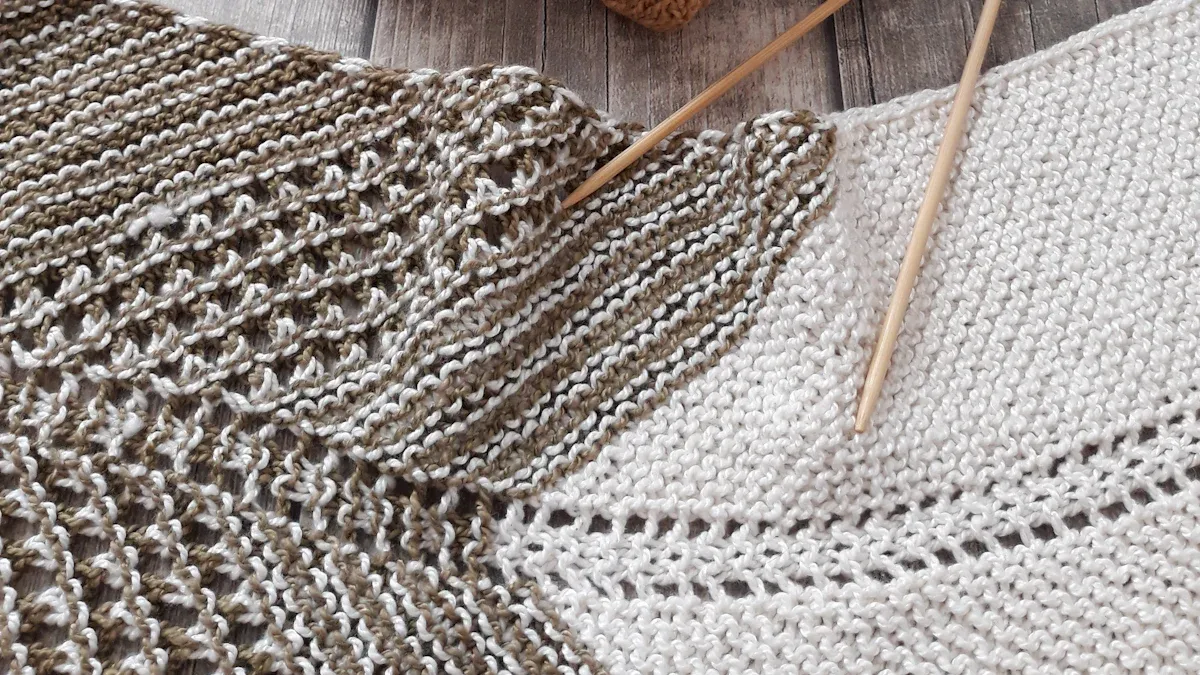
Durability
You want your knitwear to last a long time. To check if fabric is good, look at what fibers it uses and how it feels. You can do some easy tests to see if it is strong:
Stretch and Recovery: Pull the fabric to the side. See if it goes back to normal.
Light Test: Hold the fabric up to a light. If you cannot see through, it is tightly knit and better quality.
Pilling Assessment: Rub the fabric with your hand for half a minute. If you see fuzz, it might pill soon.
Twist Test: Twist the fabric and let it go. Good fabric will go back to its shape.
Color Fastness: Rub a white tissue on a hidden part. If color comes off, the dye may not be good.
Lab tests like the Martindale Abrasion Test show how much rubbing fabric can take before it wears out. Here is a table to help you understand these scores:
Test Aspect | Description |
|---|---|
Martindale Abrasion Test | Fabric is rubbed in a figure-eight until it shows wear |
Durability Ratings | Less than 10,000 rubs: for decoration; 10,000-15,000: for light use; 15,000-25,000: for normal use; more than 30,000: for heavy use |
Picking natural fibers like hemp or flax can make your clothes stronger and last longer.
Certifications
Certifications help show your fabric is good and made the right way. Look for labels like GOTS for organic fabric, GRS for recycled fabric, and Fair Wear Foundation for fair work. These labels mean your knitwear uses safe fabrics and follows rules for workers and nature. The YESS group checks for forced labor in cotton, so your supply chain is safe.
Certification Body / Standard | Scope and Criteria | Relevance to Knitwear Blends |
|---|---|---|
GOTS | Organic fibers, environmental and social criteria | Checks for organic and fair production |
GRS | Recycled content, social/environmental practices | Makes sure fabric is recycled and made right |
Fair Wear Foundation | Labor conditions, worker empowerment | Helps with fair work for workers |
YESS Initiative | Due diligence for forced labor in cotton | Keeps your supply chain safe |
Sustainability
You can help the planet by picking eco-friendly fibers and blends. Mixing cotton with hemp, flax, or jute uses less water and fewer chemicals. These blends also let air and sweat move through, so clothes feel better and are better for the earth. The Higg Index and Life Cycle Assessment help you check how green your product is from start to finish.
Hemp and flax blends save water and use fewer chemicals.
Banana and jute fibers make fabric stronger and softer.
Eco-friendly fabrics last longer and feel nice for your customers.
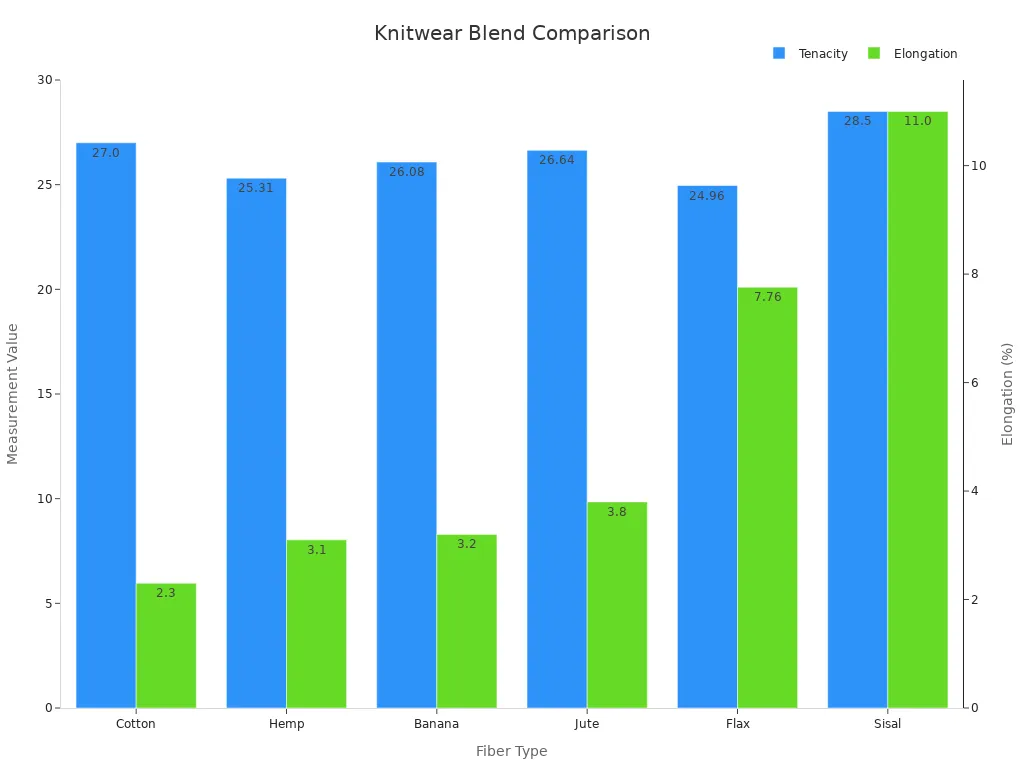
If you focus on good fabric, strength, and being green, your knitwear will stand out and help the planet.
Sourcing & Testing
Supplier Selection
You need to pick suppliers who help your brand do well. Find partners who give good prices and deliver fast. They should also have high quality and good customer service. Most people care most about price and speed for small orders. For big or special orders, quality and service matter more. If you want to make trendy knitwear, choose suppliers who work fast and support new ideas. For basic clothes that last, focus on price and quality.
Tip: Always ask about the smallest order you can make and if you can change the fabric. This helps you plan better and avoid problems.
Swatches & Prototypes
Order swatches and make prototypes before buying lots of fabric. Swatches let you touch and see the fabric up close. Prototypes show how the fabric works in real clothes. Many brands use knitting machines to make samples fast and save yarn. You can test new things, like sensors, without cutting and sewing.
Making samples quickly lets you try ideas and waste less.
You can test new tech, like touch sensors, in the fabric.
Prototypes help you show new styles to others, even when times are hard.
Testing with real people gives you feedback to make your product better.
Special tests make sure your fabric is safe and works well.
Note: Swatches and prototypes help you find problems early and make smarter choices.
Performance Testing
You want your knitwear to be good and last long. Use real tests to check fabric quality and how it feels. The Kawabata Evaluation System for Fabrics (KES-F) checks how fabric feels, stretches, and lasts. Other tests look at how the fabric feels on top, how strong it is, and how it moves. These tests give you facts, not just opinions.
Test/Standard | What It Measures | Why It Matters |
|---|---|---|
KES-F | How fabric feels, stretches, and softness | Shows comfort and quality |
Martindale | How well fabric stands up to rubbing | Shows how long fabric lasts |
How the surface feels and looks | Checks for smoothness and feel |
Testing helps you pick blends that look nice, feel good, and last long. Always test samples before making lots of clothes. This step keeps your brand safe and makes customers happy.
Choosing the right knitwear fabric blends starts with knowing your brand, your customers, and the job each garment must do. Use a checklist to guide your choices, and always test for quality and performance. Studies show that strong quality control and performance testing help you meet market needs. Data-driven frameworks like CRISP-DM and AutoML help you improve blends over time.
Listen to customer feedback and use real-time data to keep your products fresh and on trend.
Keep testing and refining as your brand grows.
FAQ
What is the best fabric blend for activewear?
You should look for blends with spandex or polyester. These fibers help your clothes stretch and wick away sweat. Cotton-spandex jersey works well for leggings and sports tops. Polyester blends dry quickly and keep you comfortable during exercise.
How do I know if a fabric blend is sustainable?
Check for certifications like GOTS or GRS. These labels show that the fabric uses organic or recycled fibers. You can also ask your supplier about eco-friendly options. Sustainable blends often use organic cotton, hemp, or recycled polyester.
Can I use the same knit fabric blend for all seasons?
You should match fabric blends to the season. Cotton-linen blends feel cool for summer. Wool or wool-blend jerseys keep you warm in winter. Some blends, like cotton-polyester, work well year-round, but always test for comfort in different weather.
How do I test the quality of a knitwear fabric blend?
Try these quick checks:
Stretch the fabric and see if it returns to shape.
Rub it to check for pilling.
Hold it up to light to see how tightly it is knit.
Why do some knitwear fabrics pill after washing?
Pilling happens when short fibers rub together and form small balls. Blends with more synthetic fibers, like polyester, may pill less than pure cotton. Choosing high-quality yarns and tighter knits can help reduce pilling.



